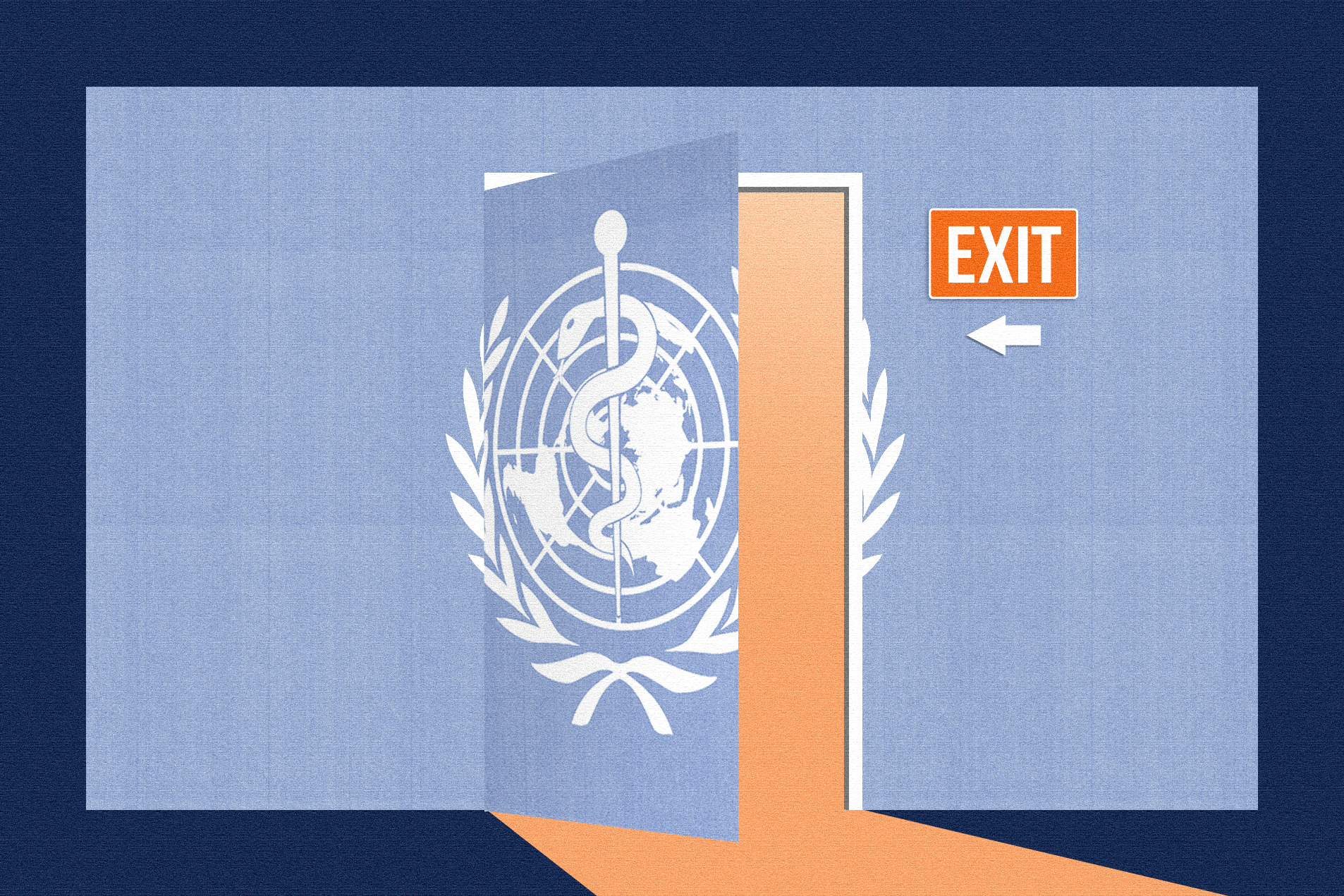As the World Health Organization celebrated the adoption of a landmark pandemic treaty in May, the United States deepened its criticism of the U.N. agency—which it contends has become corrupt, beholden to special interests, and diverted from its core mission.
“I urge the world’s health ministers and the WHO to take our withdrawal from the organization as a wake-up call. It isn’t that President Trump and I have lost interest in international cooperation—not at all,” Kennedy said, adding that the United States was already in contact with “like-minded” countries. He proposed an alternative global system, inviting fellow health ministers around the world to cooperate outside the limits of a “moribund” WHO.
In the long shadow of COVID-19, there is an increasing trend toward prioritizing pandemic response—billions of dollars for vaccines, surveillance, and high-tech attempts to find and control diseases, including those that don’t yet exist.
In a world of limited resources, this paradigm often abrades with one that prioritizes health promotion—the more banal work of strengthening local health systems and addressing underlying determinants such as nutrition, sanitation, and economic development.
The Trump administration’s Make America Healthy Again (MAHA) agenda, with its focus on holistic health promotion and the root causes of chronic disease, philosophically aligns with the latter approach.
At the same time, its exit from the WHO and its cuts to foreign aid, including the dismantling of the U.S. Agency for International Development (USAID), are sending shockwaves through the system.

The United States’ retreat raises concerns that an ensuing power vacuum could further empower authoritarian governments, such as China, and special interests, such as pharmaceutical companies.
The Next Pandemic
In an April podcast, the Geneva-based Health Policy Watch interviewed Tulio de Oliveira, a virus expert who directs Stellenbosch University’s Centre for Epidemic Response and Innovation in the Western Cape province of South Africa.De Oliveira is credited with leading teams that first detected both the beta and omicron variants of SARS-CoV-2.
He suggested that the United States was wrong to exit the WHO.
“We just came from a pandemic and how many trillion dollars used, that cost the global economy,” De Oliveira said.
“The U.S. donates less than 1 percent of the GDP [to global public health]. A pandemic will cost them much more than 1 percent a year,” he said, noting that the bird flu was spreading rapidly, decimating avian populations and driving up the cost of eggs and poultry.
The Moderna bird flu vaccine uses messenger ribonucleic acid (mRNA), which is also used in its COVID-19 shots.
HHS communications director Andrew Nixon told The Epoch Times in an email, “The reality is that mRNA technology remains under-tested, and we are not going to spend taxpayer dollars repeating the mistakes of the last administration, which concealed legitimate safety concerns from the public.”
De Oliveira said he hopes that the United States and other countries—including the UK, which weeks earlier had announced that it would cut roughly 40 percent of its foreign aid budget—will reconsider.
“You have to defend your population and now you have a bigger chance of epidemics to emerge. ... It’s about investing money,” he said, adding that there is a “much better benefit” to doing so than from being hit “by waves of new pathogens and epidemics.”

In recent years, international organizations including the WHO, the World Bank, and the G20—a forum for economic cooperation among the world’s largest economies—have sought tens of billions of dollars in annual funding for pandemics, largely for vaccine development, surveillance, and digital technologies.
‘Grossly Exaggerated’
“The whole messaging on the risks of pandemics and the risks of outbreaks that these are based on is false,” Dr. David Bell, a clinical and public health physician who has spent more than two decades in global health, including as a medical officer and scientist with the WHO, told The Epoch Times.“We have gone through carefully the WHO messaging on all this and their citations and their evidence—as well as that [used by] the World Bank, the G20, et cetera. They’re all giving grossly exaggerated or false messaging around the risks of pandemics,” Bell said.
But remove COVID-19 and the 2009 H1N1 (swine flu), according to Bell, and the combined burden of all outbreaks referenced between 2000 to 2020 is fewer than 26,000 deaths.
“Swine flu killed less people than seasonal influenza normally does, and we already have well-established surveillance mechanisms for influenza,” Bell and the co-authors wrote. “In this context, COVID-19 appears as an outlier rather than reflecting a trend.”
While the G20 panel argues that $15 billion per year is the absolute minimum the world must invest in pandemic prevention, Bell said the total requested is closer to $34 billion, or $171 billion over five years.
In a May 2024 report on the cost of pandemic preparedness, he warned that estimated spending for pandemic prevention—which could be as much as 55 percent of global overseas development aid spending for health—threatens to shift scarce resources away from “high-impact” investments on greater disease burdens.
Neither De Oliveira nor the WHO responded to emailed inquiries from The Epoch Times regarding Bell’s analysis and related questions.

Core Mission, Shifting Priorities
While billions are being invested in speculative pandemic planning, the greatest emerging disease threats in 2025 are not unidentified viruses but the same “slow pandemics” that the WHO has been fighting for decades—tuberculosis, HIV and malaria—according to GAVI, the public-private vaccine alliance of which WHO is a founding member.“You’re much more likely to die of tuberculosis, of malaria, of diarrhea, if you are malnourished and your micronutrients are depleted,” Bell said, explaining that nutrition used to be a major WHO focus but that funding has since dropped.
“If you want to build resilience against pandemics and all other diseases, then the first thing you do is look at nutrition,” he said. “We are not making great progress against these big killer diseases.”
He pointed to the fact that malaria kills mostly children younger than age 5, and tuberculosis and HIV impact mostly young and middle-aged adults, as well as children, whereas COVID-19 impacted mostly older adults.
“So where would you put your resources? Not in COVID. But that’s what the WHO did and the reason for that is because there was a financial imperative to do so,” he said, of the vaccine-driven COVID-19 response.
When it comes to overseas development assistance, requests for pandemic aid are more than triple the total malaria spend, Bell said. Meanwhile, new organizations such as GAVI, the Vaccine Alliance, and the Coalition for Epidemic Preparedness Innovations, are dedicated exclusively to pandemics and vaccines.
“So all of this money in addition to diversion of WHO spending,” Bell said. He noted that the Global Fund—whose stated purpose is to fight AIDS, tuberculosis, and malaria—is also increasing allocations to pandemics over those diseases.

Donor Driven
More broadly, the context for shifting priorities at the WHO has to do with how the organization is funded.As the agency has become increasingly reliant on “specified” voluntary contributions—from the private sector, governments, and now public-private alliances—these earmarked funds now make up a larger part of its budget than core fees paid by member states.
“If you go back 40, 50 years, the whole emphasis was horizontal-based health care where community control is emphasized and the basic drivers of good health, such as nutrition, sanitation, living conditions,” Bell said.
Now, he said, focus has turned to commodity-based responses to disease, such as vaccines, implemented by a vertically controlled and increasingly centralized bureaucracy.
It’s not the WHO driving this change, Bell said, “It’s the funders.”
Elisabeth Paul, an expert in global health systems who has spent decades in the field in developing countries, said this is a significant divergence from WHO’s core mission.
“Instead of being a kind of normative agency that supervises and helps countries improve the performance of their health systems, now it becomes just an implementing agency for donor priorities,” said Paul, an associate professor at the School of Public Health at the Université Libre de Bruxelles and director of its research center on health policies and systems.
“And of course, there are conflicts of interest because of corporate influence, notably the pharmaceutical industry.”
Within pandemic preparation, Paul said, vaccines tend to be seen as the only solution.
“Look what took place with COVID-19—there was an incredible budget for vaccines, and nearly nothing on health system strengthening more broadly, or treatments. There is a kind of myth that vaccines are efficient, cost effective, and the only solution,” she said.
“And people forget about the whole continuity of health care.”

Disease Hunters Versus Health Promoters
Behind this divergence in global public health priorities, Paul said, is a fundamental ideological divide.“In our business, there are really two kinds of people: those who fight diseases and those who promote health,” she said.
“[Fighting diseases is] much more sexy, and it’s much easier to convince the public and the funders,” Paul said. “There are people who would be so proud or excited about trying to eliminate the disease, and then they totally forget there are other diseases and there are root causes.”
By isolating diseases into silos, she said, health experts can miss the underlying conditions that protect populations from all pathogens.
“How do you prepare for or prevent pandemics? It should normally just be by strengthening your health systems. If you have a good health system and the population is healthy—like the MAHA agenda—then you are prepared for future pandemics,” Paul said.
The way success is measured can also be misleading.
“For instance, a cost-benefit analysis shows that if you invest, say $1,000, you can save one life with a vaccine or another intervention. So you take a child who receives 10 vaccines, he’ll be counted 10 times—he’s been saved 10 times because he received the 10 vaccines,” Paul said. “But he might die the next day from malnutrition.”
Showing how lives are saved by hiring more nurses, she said, may not be as straightforward.
Dr. Mohamed Lamine Dramé, a public health systems and policy expert who has worked for the WHO and various European governments throughout Africa for decades, describes a similar scenario in programs from the World Bank, the WHO, the European Union, and others.
“Projects are not always co-constructed,” he said, referring to a lack of consultation with local stakeholders. “They usually come with a one-size-fits-all [solution]. In two years’ time, ... we have to reach our indicators.”
It’s possible to reach a goal of immunizing 90 percent of children, Dramé said.
“But meanwhile, you don’t have service provision against malaria, diarrhea, or respiratory illnesses. And they will die from malaria,” he said.
Dramé, also a member of the independent review committee of GAVI, suggests that the focus has become too concentrated on emergency response.
Paul stressed that socio-economic and political factors lie at the root of disease burden and mortality. She said she is wary of what she describes as an increasing overreliance on technological solutions, including in the pandemic prevention agenda.
“Most global health problems are due to social, economic, and political determinants of health, the huge inequality and all the risk factors. It’s political; it’s not technological,” she said.

Collapse or Reform?
Withdrawal from the WHO and cuts to U.S. aid elsewhere will impact health programs worldwide in the short term, but may ultimately be beneficial, some experts say.But the agency’s problems predate U.S. withdrawal. Even with its support, most critical initiatives at the WHO have been chronically underfunded, a problem that Bell argues is exacerbated by the divergence of funds toward pandemic prevention and by donor-driven priorities.

According to Paul, the United States’ retreat will be bad for countries that rely on WHO programs in the short term, but will force the organization to eliminate redundancies, including staffing at its Geneva headquarters and regional offices.
Recent cuts have already improved things, she said.
“The new program is not perfect but [is] much better than it used to be,” Paul said.
Many programs that are being cut were not very efficient or effective to begin with, she said. Duplication and inefficiencies arose from the fact that funding is organized “into silos,” directed to specific programs, diseases, or subjects.

Will China Fill the Vacuum?
Some worry that authoritarian states will step into an ensuing vacuum.While China has historically contributed much less than the United States, relative to its population size—in 2024–2025, it was slated to give $175 million in mandatory fees, compared to America’s $261 million—it has recently pledged $500 million in voluntary funds over the next five years.
Bell said that, in theory, given its population size, it would be appropriate for China to have more influence at the WHO, as long as the organization plays an advisory role rather than mandating or enforcing countries’ health agendas.
While the United States and others cited concerns over sovereignty as the final draft of the pandemic treaty was adopted, the WHO said it doesn’t grant authority to direct national or domestic law—and specifically, it cannot mandate requirements including travel bans, vaccination mandates, therapeutic or diagnostic measures, or lockdowns.
A Bigger Issue: Financial and Corporate Influence
Bell stressed that the issue is bigger than the treaty and even the WHO itself.“It doesn’t need a police force,” he said of the agency. “There are very large financial and corporate institutions behind this idea that we should be prioritizing [pandemics] and putting public money into this area so that private companies can make a lot of money out of it. There are many ways of persuading states.”

Smaller countries in particular will be hard-pressed to dissent, Bell said. “It is very difficult to go against this if the financial institutions start restricting access to finance, for example, unless you introduce mandates, you shape up your surveillance, et cetera,” he said.
While agreeing that Kennedy’s invocation of MAHA principles presents a chance to overhaul global health, Paul said she thinks that the existing system should be reformed; Bell said he supports Kennedy’s push for an alternative.
Dramé said he thinks that the U.S. withdrawal can be an opportunity for African countries to increase their domestic public health funding, focus on diplomacy, and attract investments.
“We welcome what Bill Gates is doing, but we have Bill Gates in Africa,” he said, referring to the continent’s own billionaires.
Africans living outside the continent send home $95 billion in remittances each year, of which 1 percent or 2 percent could make a seismic difference in national health systems, Dramé said.
He recalled the HIV pandemic: The Joint U.N. Programme on HIV/AIDS was created in 1996, after the WHO dragged its feet responding to the looming crisis.
“I think the WHO structure, they have to rethink it,” Dramé said. “It should not continue working as usual.”











